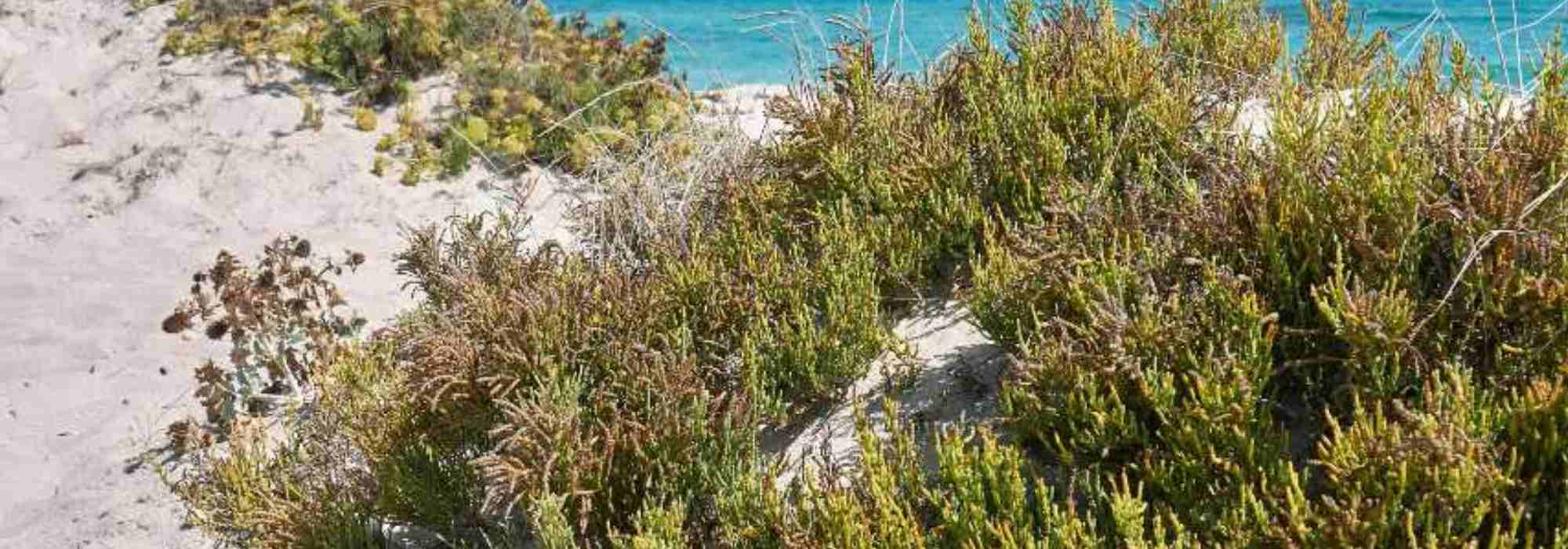
Sea Purslane - Sea Pickle: Planting, Growing, and Harvesting
Contents
Samphire in a nutshell
- European glasswort is remarkable for its ability to thrive in environments with high saline concentrations, such as salt marshes and coastal areas.
- The young shoots of glasswort are prized for their unique salty taste and crunchy texture.
- Glasswort contributes to the stabilisation of saline soils and the creation of habitats for various animal species.
- Due to its tolerance to salinity and its ability to grow in polluted soils, Salicornia europaea is being studied for its use in phytoremediation.
- Growing glasswort can be attempted in the garden under specific conditions, requiring full sun exposure and well-drained soil.
The word from our expert
Glasswort, scientifically known as Salicornia europaea, is a fascinating annual plant that thrives in coastal areas and salt marshes. Adapted to high salinity conditions, this salt-loving plant stands out for its ability to flourish where few species can survive. Its fleshy stems, ranging from green to reddish, are consumed fresh or preserved, often compared to asparagus for their crunchy texture and unique salty taste.
Cultivating glasswort primarily occurs in coastal zones, but it can also be integrated into domestic gardens, provided a similar environment to its natural habitat is recreated. One method involves using cultivation trays with a saline water solution to irrigate the plants, mimicking the conditions of salt marshes. Glasswort requires full sun exposure and well-drained, low-organic soil to thrive.
Beyond its culinary appeal, Salicornia europaea offers notable ecological benefits. It plays a crucial role in stabilising saline soils and creating habitats for wildlife, contributing to the biodiversity of coastal ecosystems. Additionally, this plant is studied for its biofiltration properties, capable of purifying salt-laden and polluted waters, making it a promising subject for phytoremediation research.
Harvesting glasswort typically occurs from spring to summer, before the plant flowers, when its stems are at their most tender. Young shoots can be eaten raw in salads or cooked as a companion vegetable. Rich in minerals, particularly iodine, potassium, and vitamin A, they provide a healthy and original alternative to enrich the diet.
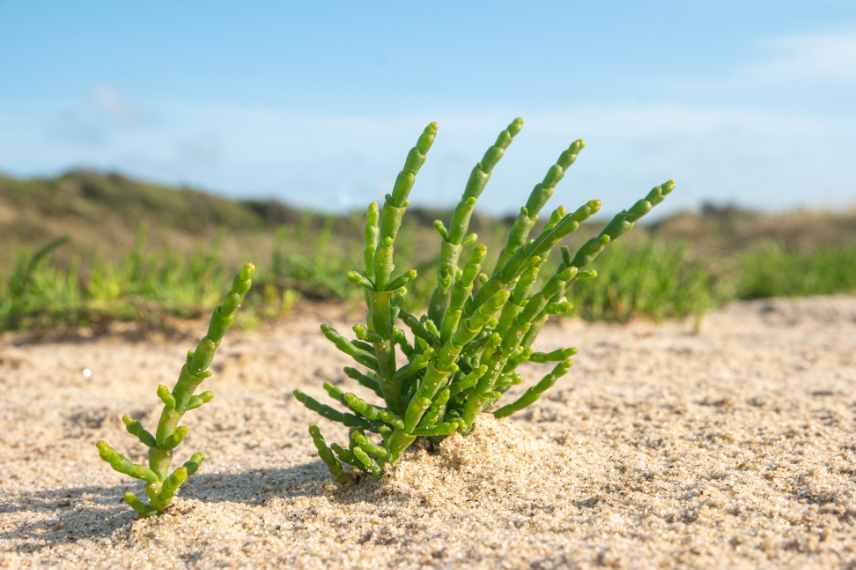
Glasswort grows in sandy and saline substrates
Botany and description
Botanical data
- Latin name Salicornia europaea
- Family Amaranthaceae
- Common name glasswort, samphire, sea pickle
- Flowering July to September
- Height 30 cm
- Exposure sun or partial shade
- Soil type sandy and saline
- Hardiness -15°C
The genus Salicornia belongs to the Amaranthaceae family (formerly classified in the Chenopodiaceae), which includes a wide variety of plants, ranging from herbs to bushes, known for their ability to adapt to diverse environments, including those with high salinity. This genus is characterised by its unique adaptations to saline environments, making it a fascinating subject of study for botanists and ecologists. The genus Salicornia comprises around 30 species, although this number may vary depending on classifications and recent scientific discoveries. These species are distributed across different regions of the world, primarily in coastal areas and salt marshes.
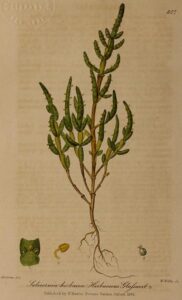
Species of the genus Salicornia share several distinctive traits:
- Fleshy stems: The plants feature succulent stems, often green in colour, which may turn reddish or purple with age, storing water to cope with the salinity of their habitat.
- Reduced leaves: The leaves are typically reduced to simple scales, minimising water loss through evapotranspiration.
- Absence of visible flowers: The flowers of Salicornia are small, often hidden in the cavities of the stems, adapted for pollination in windy and saline environments.
- Adaptation to salinity: These plants possess physiological mechanisms enabling them to tolerate, or even thrive, in salt-rich soils where few other plants can survive.
Salicornia species are primarily found in saline coastal habitats, such as salt marshes and intertidal zones (areas affected by tidal movements). They play an important ecological role in these environments, contributing to soil stabilisation and providing habitat for numerous animal species. Their presence often indicates a high concentration of salt in the environment, limiting competition with less adapted plants.
Their ability to survive and thrive in extreme conditions makes them of interest for research in ecology, phytoremediation, and even agriculture in areas affected by soil salinisation. Glasswort and its relatives in the same genus continue to inspire innovations in the management of saline ecosystems and sustainable food production.
Did You Know? Glasswort has remarkable adaptations for surviving in its saline habitat, thanks to sophisticated physiological and cellular mechanisms. It manages excess salt through a process of sequestration and excretion, storing salt in its vacuolar cells to keep it away from vital metabolic processes, then eliminating it through its leaves and stems if necessary. This strategy allows it to maintain optimal water balance and prevent salt toxicity, ensuring its growth and reproduction in conditions that few other plants can tolerate. Moreover, its ability to perform photosynthesis even in the presence of high salt concentrations is an example of its exceptional adaptation, making glasswort a model for studying salt tolerance in plant biology.
Salicornia europaea, commonly known as European glasswort, is a fascinating annual plant adapted to saline environments such as salt marshes and coastal areas. In France and elsewhere in Europe, it is mainly distributed along coastlines, where it plays an essential ecological role in stabilising soils and providing habitat for various species. For example, salt marshes rich in glasswort serve as nesting grounds for several species of migratory and local birds, such as avocets and black-winged stilts, which find both refuge and food there. Dense glasswort areas also act as nurseries for many fish and crustacean species, with fry and young crustaceans finding protection from predators and abundant food. Insects, including certain specific species of butterflies and bees that feed on glasswort nectar, also benefit from these habitats, playing a crucial role in pollination processes within these environments.
European glasswort has a distinctive appearance with its fleshy, succulent green stems, which may turn reddish as autumn approaches. The plant can reach up to 30 cm in height, often forming dense mats or clumps. Its unique structure is perfectly adapted to water retention in saline environments.
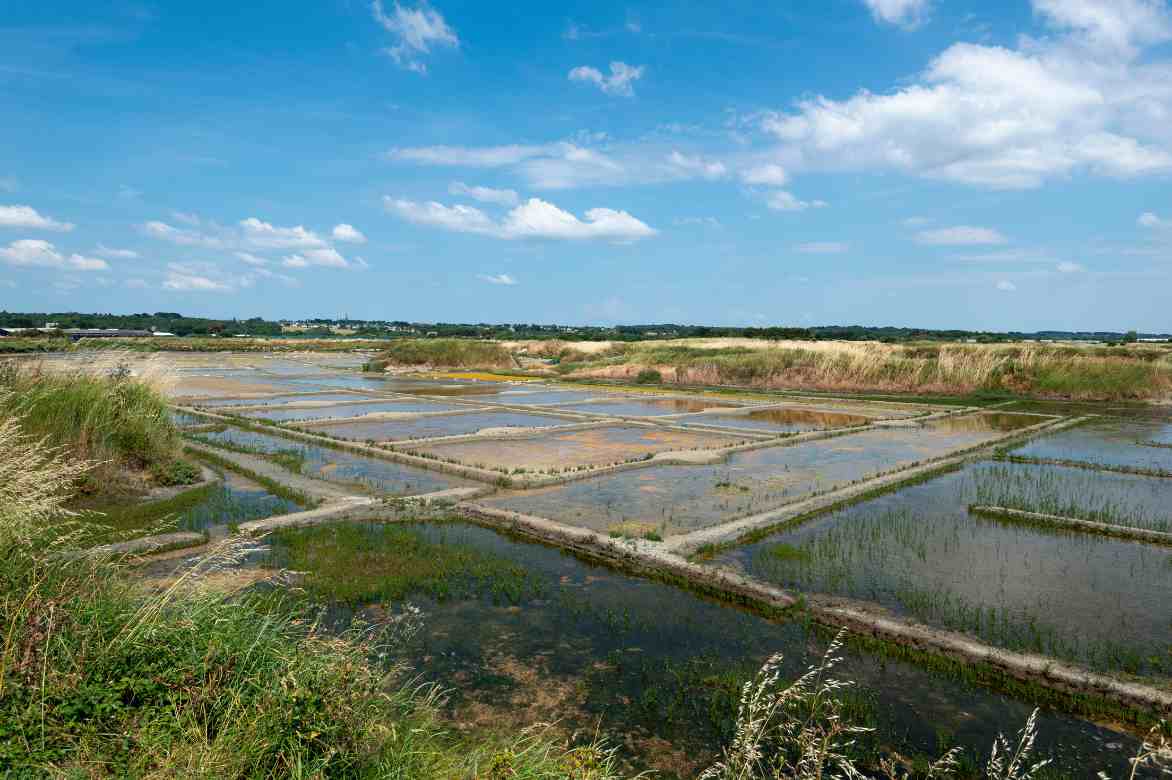
Salt marshes of Guérande (44): glasswort thrives here
These fleshy, jointed, and segmented stems give the plant its characteristic “green coral” appearance. The leaves are reduced to simple scales, fused around the stem, minimising the surface area for evaporation and allowing the plant to conserve water in its saline environment.
The flowering of European glasswort occurs from July to September. The flowers are tiny, almost invisible to the naked eye, inserted into the joints of the stems. Despite their small size, they play a crucial role in the plant’s reproduction.
The seeds of Salicornia europaea are small and produced in large quantities at the end of the growing season. They are dispersed by water or animals, enabling the plant to colonise new habitats.
The roots of glasswort are relatively shallow but effective at absorbing water and nutrients in saline soils. They also allow the plant to anchor itself in often shifting and unstable substrates.
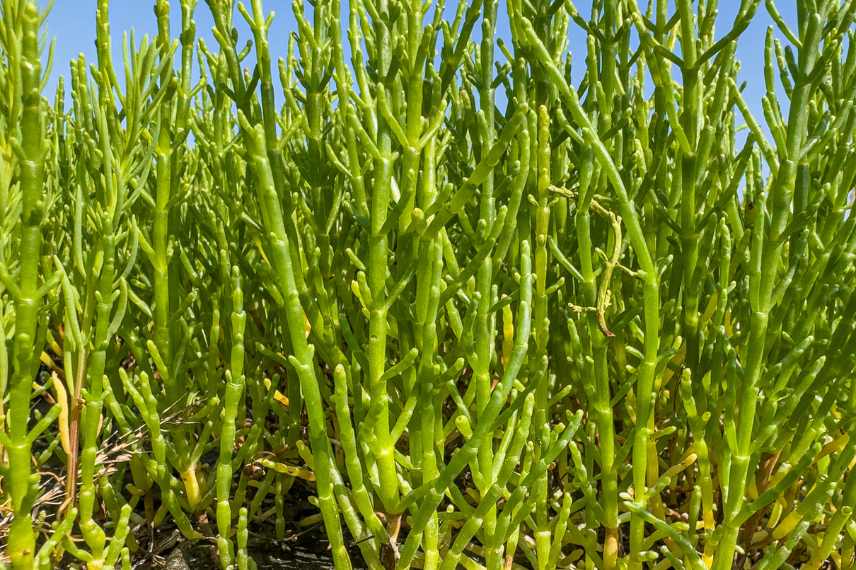
The scales and stems of glasswort: a green coral!
An edible plant? Absolutely!
Glasswort, with its richness in minerals such as iodine, magnesium, and potassium, as well as vitamins A, C, and D, stands out for its beneficial nutritional profile. In cooking, it is used fresh in salads to add a crunchy, salty touch, or steamed as an alternative to asparagus, garnished with a knob of butter or a squeeze of lemon. Its unique flavour, both marine and salty, works wonders in fish and seafood dishes, where it adds a taste reminiscent of the ocean. Chefs also appreciate it for its ability to enhance the flavours of vegetarian dishes, offering a healthy and tasty alternative to traditional herbs.
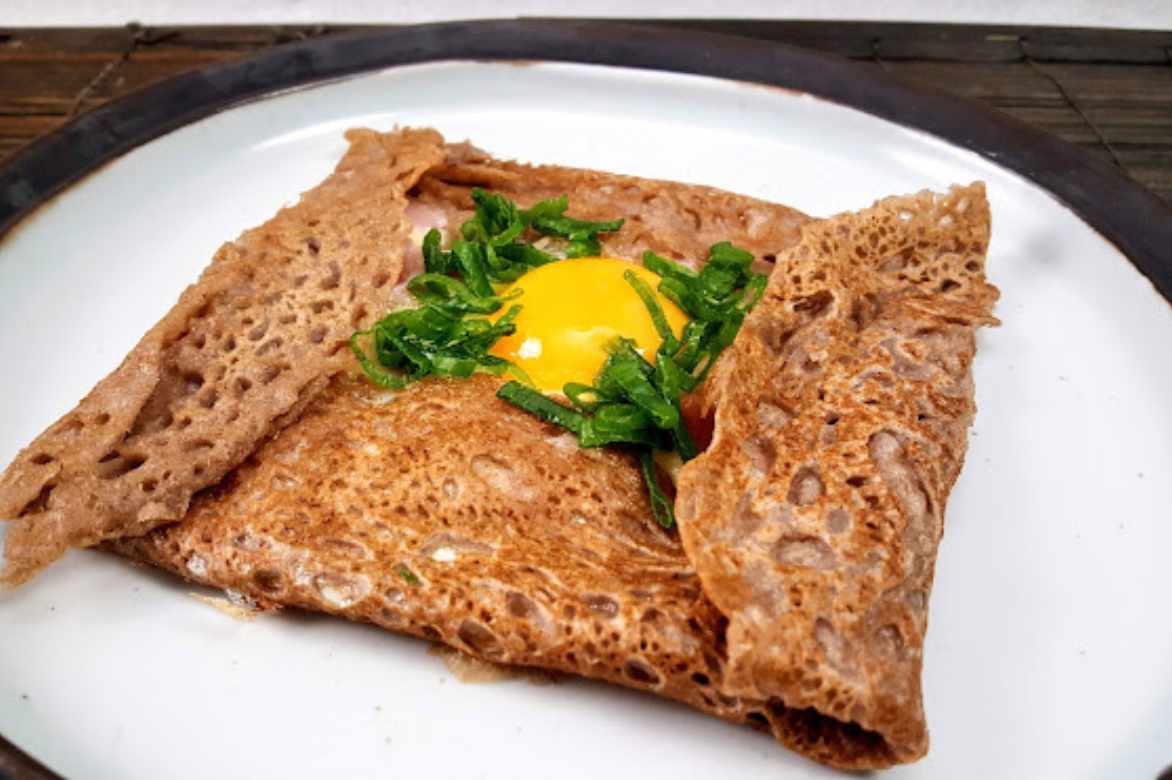
Glasswort also traditionally accompanies buckwheat galettes (photo Bloc notes culinaire)
Good to know: it’s another botanical genus, but there is a Japanese glasswort that can also be grown in our vegetable gardens. The Japanese glasswort, (Salsola komarovii), is a distant annual cousin of our European glasswort. It is also known as Land seaweed, Japanese sea bean, or Okahijiki in Japanese. Its natural habitat is bathed in sunlight in the salt marshes of the northern coasts of China, Korea, and Japan. The plant is characterised by its fleshy stems, harvested young for consumption, offering a crunchy texture and a flavour that is both salty and iodine-rich, reminiscent of the ocean. Used in traditional Asian cuisine, Japanese glasswort enhances sushi, elevates salads, serves as a side dish similar to green beans, or is enjoyed pickled in vinegar.
Read also
10 unusual and curious vegetablesOur best varieties
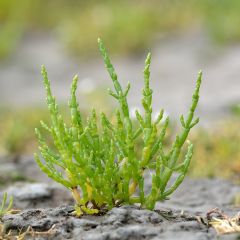
Salicornia europaea - European Glasswort, Sea Pickle
- Flowering time August to October
- Height at maturity 30 cm
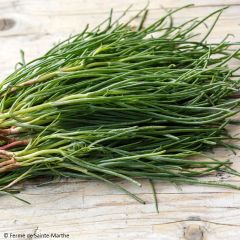
Japanese Glasswort NT - Ferme de Sainte Marthe seeds
- Flowering time July to September
- Height at maturity 40 cm
Planting Glasswort
Where to Plant?
Prefer a sunny spot, as glasswort thrives under direct sunlight.
Glasswort flourishes in saline soils, so to cultivate this plant in a non-coastal garden, it is necessary to simulate these conditions. Use a sandy substrate to ensure good drainage and add sea salt to the irrigation water (5 g per litre) to increase the soil salinity. Of course, to avoid raising the soil salinity in your garden, which would harm other plants, consider growing glasswort in containers or pots instead.
However, for gardens located near the coast, glasswort can be planted directly in the ground in areas that replicate its natural growing conditions, such as gravel gardens or rockeries.
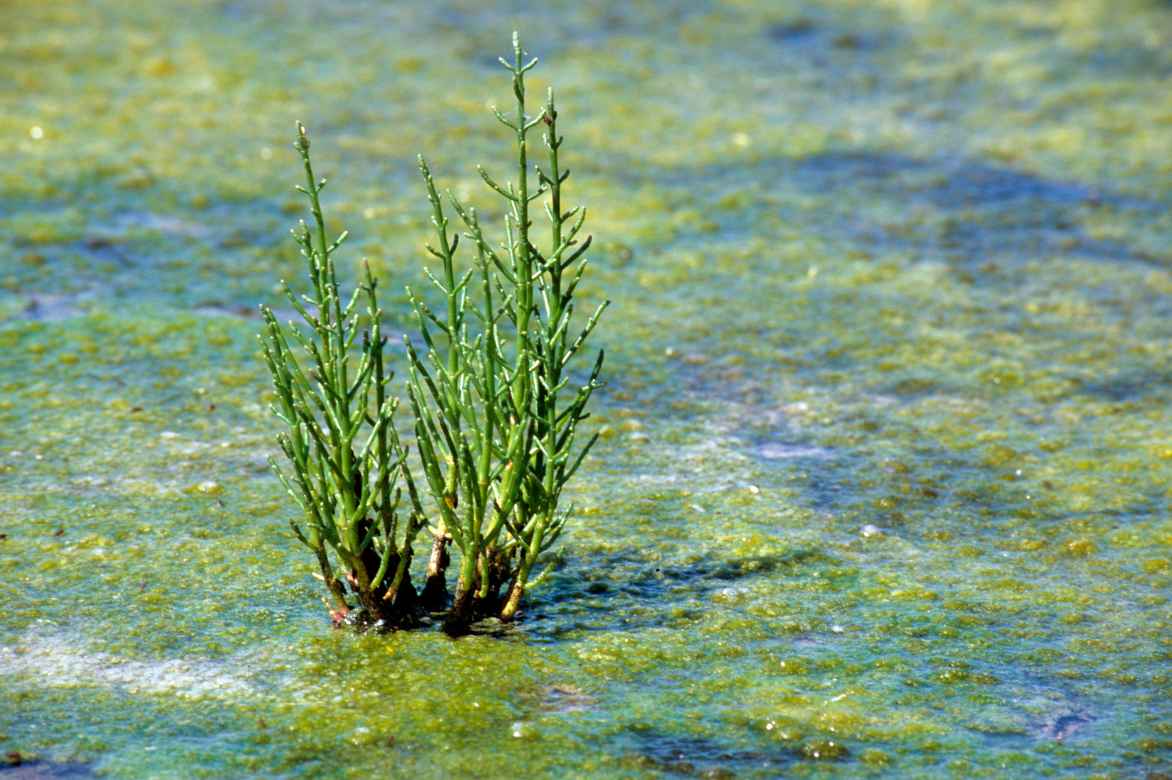
Replicate the natural growing conditions of glasswort
When to Plant?
Wait until the risk of frost has passed and the soil temperature has risen sufficiently. Glasswort germinates best when the soil is at least 15°C, which often corresponds to April or May in the northern hemisphere, depending on the local climate.
How to Plant?
Transplanting European glasswort is quite delicate, but young plug plants or bucket-grown glasswort are available commercially. The plug plant is likely the best compromise between sowing and planting an already well-rooted plant. However, here’s how to sow your glasswort:
- In spring and in a sandy substrate, which mimics the natural coastal environment of glasswort, sow the seeds on the soil surface, as they need light to germinate. You can cover them with a very thin layer of soil or sand, but ensure they are not buried too deeply.
- Sow the seeds in rows spaced 20 to 30 cm apart, scattering them lightly to allow for good plant development.
- After sowing, water gently with slightly salted water to avoid dislodging the seeds.
- Keep the soil moist but not waterlogged during germination.
- Glasswort seeds should germinate within 7 to 14 days, depending on temperature and moisture conditions.
- Harvesting can begin when the plants have reached a suitable size, usually a few weeks after germination. Harvest the young shoots for a crisp texture and optimal flavour.
For planting plug plants or bucket-grown plants:
- Plant in spring, after all risk of frost, when the soil begins to warm up.
- Make holes spaced 20 to 30 cm apart to allow for good plant development. The spacing between rows should be about 30 cm to facilitate access and air circulation.
- Carefully remove the plants from their buckets or handle the plug plants very gently if you’ve opted for this solution, taking care not to damage the roots. Place each plant in a hole and adjust the planting depth so the collar of the plant is level with the soil. Fill in the holes and lightly firm the soil around the plants to eliminate air pockets.
- Water immediately after planting with slightly salted water to help the plants settle in and begin adapting to their new environment.
Read also
Conserver les légumes du potagerMaintenance of Glasswort
The care of European glasswort (Salicornia europaea) in the vegetable garden requires simulating its natural habitat to promote its growth. This involves watering with slightly salty water.
- Salinity: Glasswort requires regular watering with slightly salty water to mimic its natural environment. You can add around 5 grams of sea salt per litre of water. However, always start with a fairly low concentration and observe the plants’ reaction, adjusting the salinity as needed.
- Frequency: Water enough to keep the soil moist but not waterlogged, especially during dry periods. The watering frequency will depend on the climate conditions and the soil’s ability to retain moisture.
Harvest and Preservation of Samphire
Propagation of Glasswort
The propagation of European glasswort is primarily done by sowing, as this annual plant does not spread easily through propagation by cuttings or division. Here are the steps to propagate glasswort by sowing:
Harvesting the seeds
Wait until the end of the growth season when the plants have produced seeds. The stems will turn reddish, and the seeds can be harvested once they are dry. Gently shake the stems over a container to collect the seeds or rub the spikes lightly between your hands.
Seed preparation
Glasswort seeds can be sown directly without any pre-treatment. However, for colder regions or to extend the growth season, you can start the sowing indoors.
Indoor sowing
- Early sowing: Begin sowing indoors approximately 4 to 6 weeks before the last expected frost.
- Containers and soil: Use small pots or seed trays filled with a sandy potting mix. Ensure the container has good drainage.
- Watering: Water the seeds with slightly salty water after sowing, keeping the substrate moist but not waterlogged.
Transplanting outdoors
- Hardening: Before transplanting the young plants outdoors, gradually acclimatise them to outdoor conditions over a week.
- Planting: Transplant them outdoors in well-drained soil and full sun, spacing them approximately 10 to 15 cm apart. Continue watering with slightly salty water.
Direct outdoor sowing
- Timing: Sow directly outdoors in spring, after all risk of frost, when the soil has warmed sufficiently.
- Sow lightly: Scatter the seeds on the soil surface or under a very thin layer of soil. Water with slightly salty water.
- Spacing: Sow the seeds about 10 to 15 cm apart to allow for proper development.
Diseases and parasitic pests
Disease
Although very resistant to diseases, European glasswort can, if cultivated in a vegetable garden, in open ground or in pots, encounter a few minor issues.
Caused by excessive watering or poor drainage, root rot is a common problem for many plants, including glasswort. Ensure adequate watering and, most importantly, well-drained soil or substrate to avoid any issues.
Although less common due to its preferred habitat in full sun and its need for well-drained soil, powdery mildew can sometimes affect glasswort if conditions are too humid or if air circulation is insufficient. Make sure your glasswort is not smothered by other plants or planted in a too confined space.
→ Learn more with our article Powdery Mildew: How to Prevent and Treat This Disease?
Pests
Aphids can attack glasswort, particularly in young shoots. They suck the sap of the plants, which can weaken the glasswort and make it more susceptible to diseases.
→ To learn all about aphids, read the advice sheet Aphids: Control, Treatment, and Prevention.
- Subscribe!
- Contents
































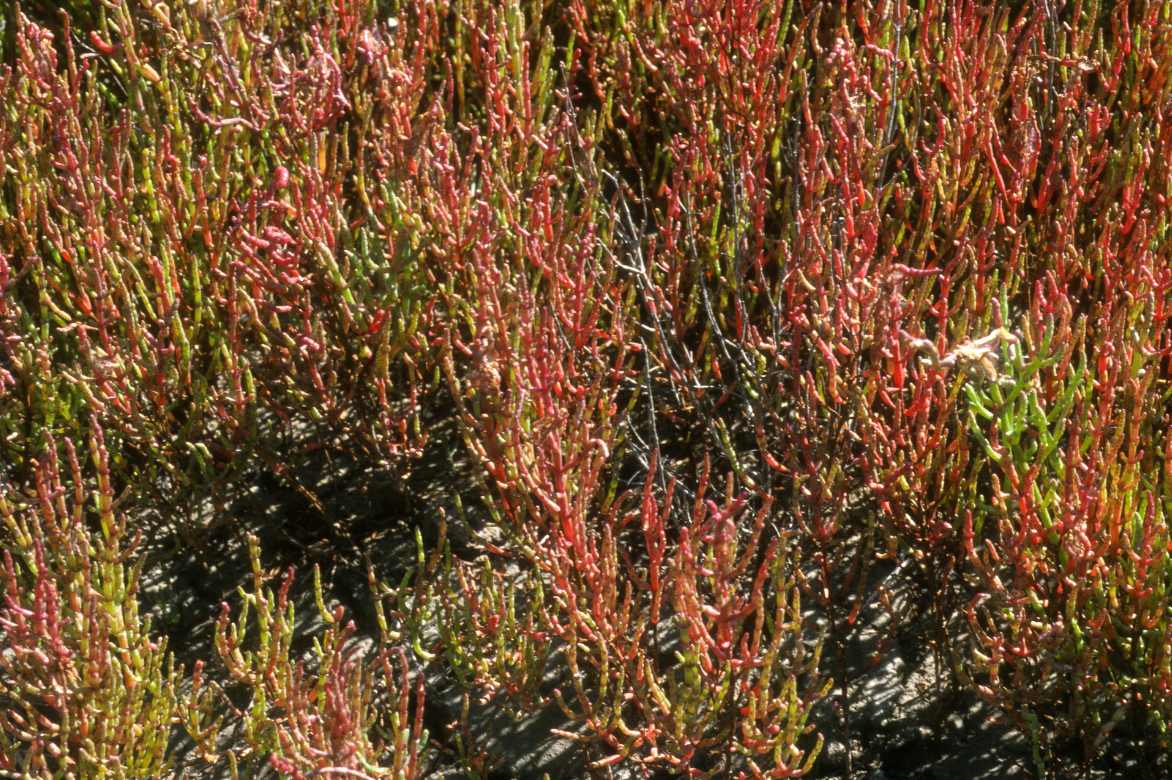 After summer, samphire, saturated with salt, turns red and woody.
After summer, samphire, saturated with salt, turns red and woody.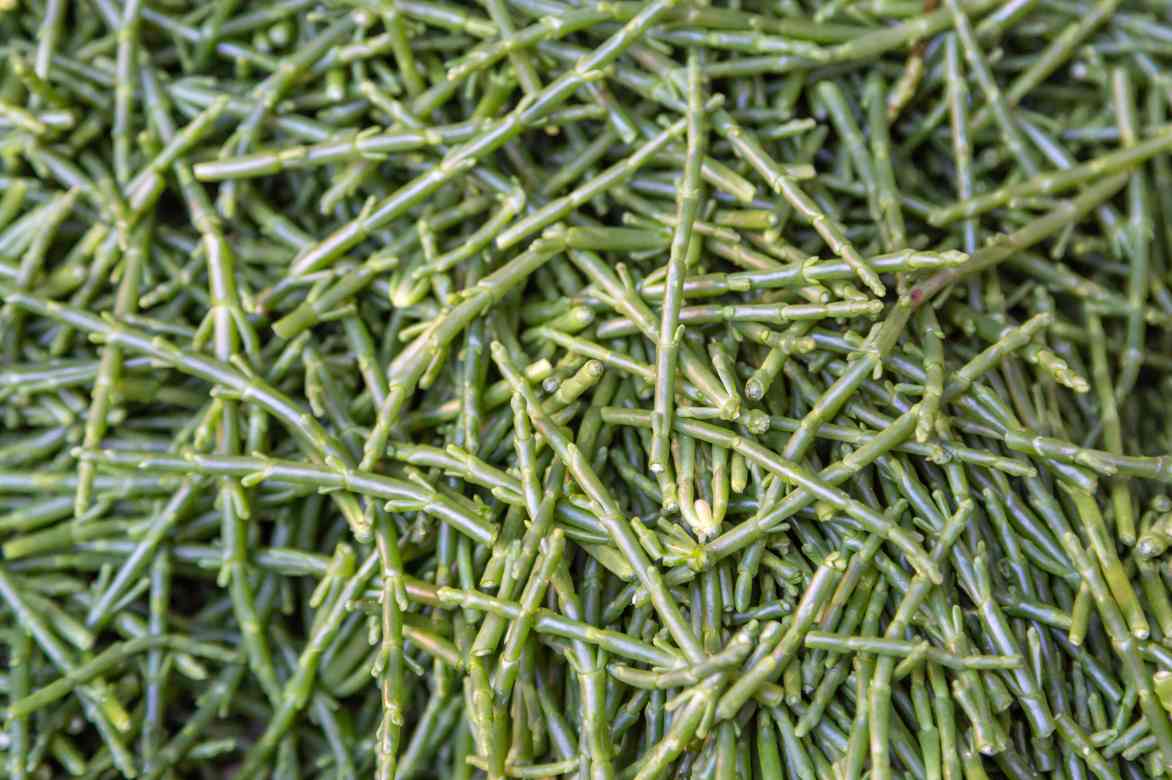
Comments